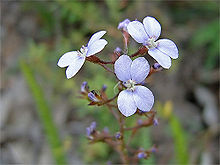Stylidiaceae
| Stylidiaceae | |
|---|---|

| |
| Stylidium amoenum | |
| Scientific classification | |
| Kingdom: | Plantae |
| Clade: | Tracheophytes |
| Clade: | Angiosperms |
| Clade: | Eudicots |
| Clade: | Asterids |
| Order: | Asterales |
| Family: | Stylidiaceae R.Br. |
| Genera | |
| Synonyms | |
|
Candolleaceae | |
The
The pollination mechanisms of
In 1981, only about 155 species were known in the family.[1] The current number of species by genus (reported in 2002) is as follows: Forstera - 5, Levenhookia - 10, Oreostylidium - 1, Phyllachne - 4, and Stylidium - 221. These numbers, especially for Stylidium, are changing rapidly as new species are described.[2]
Stylidium rotundifolium appeared in Joseph Banks' Florilegium (plate 173), drawn from a specimen collected at Endeavour River, Australia in 1770.[3]
Taxonomy
The genus
Donatioideae and Stylidioideae were described by Johannes Mildbraed in his 1908 taxonomic monograph of the family. The subfamilies were created to distinguish the difference between the five typical genera of the Stylidiaceae from the single genus Donatia, which Mildbraed placed in Donatioideae.[6] The subfamily taxonomy represents the taxonomic uncertainty of Donatia, which has often been placed in its own family, Donatiaceae, or other families such as the Saxifragaceae.[2][7]
Mildbraed's classification also included two tribes: Phyllachneae, which included the genera Forstera and Phyllachne, and Stylidieae, which included Levenhookia, Oreostylidium, and Stylidium.[6] This level of infraspecific taxonomy is not used in recent research, but the groupings are supported by molecular data that suggest Forstera and Phyllachne are closely related but distinct from the other three.[2]
APG II places Stylidiaceae and Donatiaceae in the
References
- ISBN 0-231-03880-1.
- ^ a b c Wagstaff, S.J. and Wege, J. (2002). Patterns of diversification in New Zealand Stylidiaceae. American Journal of Botany, 89(5): 865-874. (Available online: HTML or PDF versions).
- ^ "'Discovering the Unexpected' · Type & Forme". www.typeandforme.com. 6 October 2018. Retrieved 10 October 2018.
- ^ Stylidiaceae (at the Angiosperm Phylogeny Website)
- Wikidata Q95465107.)
{{cite journal}}: CS1 maint: multiple names: authors list (link - ^ a b Mildbraed, J. (1908). Stylidiaceae. In Engler, A. Das Pflanzenreich: Regni vegetabilis conspectus, IV. 278. Leipzig, 1908.
- ^ Good, R. (1925). On the geographical distribution of the Stylidiaceae. New Phytologist, 24(4): 225-240.
